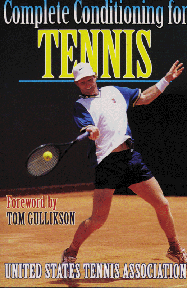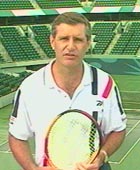Periodization Training for Tennis
Part 14
By Dr. Paul Roetert
Quickness and Agility Drills
Two key components in periodization training are aerobic and anaerobic training. Most people understand the concept of aerobic training - sustained, rhythmic exercise that elevates your heart rate and keeps it there for a certain period. Common examples are running or swimming, or using stationary bikes, stairmasters, treadmills, etc.
Developing an aerobic base is important to give yourself the stamina to play long matches. The process is quite straightforward: 20 to 30 minutes of continuous exercise 3 times a week at 60 to 85 percent of your maximum heart rate.
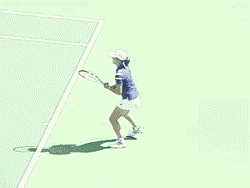 |
Many tennis players do regular aerobic training, but overlook a second type of training that is equally if not more important for tennis. This is anaerobic training. Anaerobic exercise is high intensity, short duration bursts, such as sprinting, or playing tennis points.
Without getting overly technical, it important to know that anaerobic exercise uses a completely different energy system in the body. Complete conditioning for tennis requires that a player train the anaerobic system as well as the aerobic.
Pro matches, for example, are made up of 300 to 500 short energy bursts. There is a rhythm of burst and recovery: the "bursts" or the points themselves, followed by somewhat longer periods of recovery, that is, the time between points. An average point lasts 5 to 10 seconds, with up to 5 sudden changes in direction. This is followed by 20 to 25 seconds of rest.
Tennis is a continuous series of brief, intense anaerobic bursts, followed by longer periods of rest. Repeated over time, tennis points have an aerobic component, because hundreds of repeated bursts ensure that your heart rate will stay elevated over the course of a match. But the core aspect of the game - playing great points - is actually anaerobic.
Periodization training, as we have been saying, can raise your level play an entire NTRP category without any changes in your strokes. But a critical part of generating improvement is improving your anaerobic fitness. This will improve your quickness, your agility, your ability to get to difficult balls, and your balance. It will also allow you to sustain a high quality of stroke production over the course of a long match.
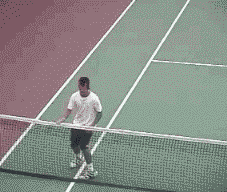 |
W-Drill
Purpose: This drill simulates backpedaling for a overhead, shuffling to recover in a groundstroke rally, and also sprinting forward for a short ball.
Drill: Start at one net post facing the net. Backpedal to the corner. Side shuffle to the T and back to the other corner. Now sprint forward to the Net post.
The next several articles will outline a series of on court anaerobic exercises. We'll start with a series of general movement drills, and then add ball and racket drills. These drills generally should be done at the end of a practice session. In the last articles in this series I'll show you how to combine them with all the other elements in our system in a periodization training schedule designed to help you peak at the right times for competition. If you want to see how it all fits together now, you can order the Complete Conditioning for Tennis Book. It also has additional movement and ball and racket drills.
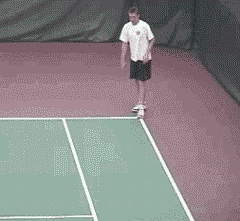 |
Alley Hops
Purpose: This is an explosive drill that will increase leg strength.
Drill: Hop side to side and forward touching the sidelines of the doubles alley until you reach the net. Touch down as lightly as possible. If you can't reach the sidelines, just hop as far as you can.
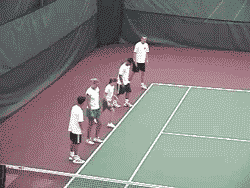 |
Suicides
Purpose: This drill helps develop quick stops and starts and increases speed to the ball.
Drill: Start on the doubles sideline facing across the court. Sprint to each line, touch it, and return to the doubles sideline.
 |
Cone Hops
Purpose: This drill also builds explosive leg strength.
Drill: Hop forward with both feet together over all three cones. You can increase the distance between the cones as you improve.



